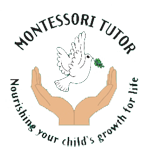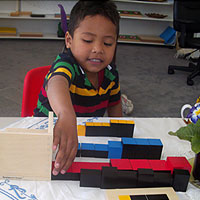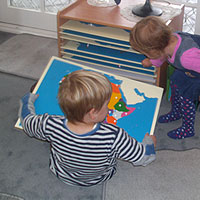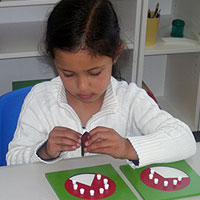The Montessori 3 – 6 program is designed for the 3 to 6 year old children to prepare them for life as well as the primary school experience. It is also ideal for those children who cannot attend a Montessori school, or prefer a smaller group to get a more focused one-to-one attention from the Montessori directress/tutor.
The close observation possible by the experienced Montessori tutor in this program facilitates the development of an individual program for your child based on your child’s special needs and interests.
At the turn of the last century, Dr. Montessori discovered that children under six have an innate ability to absorb knowledge from their surroundings just by being part of it. She called this period of learning “The Absorbent Mind” and it is at its peak receptivity during the pre-school years. At this age, the children are intensely curious and need to discover and explore their surroundings. The children are also keenly attuned to their senses at this age and they love to explore shapes, textures, smells, colours, sounds and tastes. They are also at the age where they want to know about other people and customs and where they fit in the grand scheme of things. Children at this age also need to have “everything in its place” and a routine to follow.
In the Montessori prepared environment, the directress/tutor is not a teacher who teaches directly to the children. She is a “facilitator” who provides the children with opportunities and activities to meet each individual’s needs. The children are free to move around the Montessori room and choose work independently. The children are given an initial step by step presentation with the material and then the directress/tutor steps back to allow the children to explore and discover the properties of that particular piece of material. The children are free to move around the room and choose work without the interference of an adult. This freedom allows children to learn at their own pace and develop initiative, independence, inner discipline and concentration.
The Prepared Environment is usually divided up into five curriculum areas as follows:
• Practical Life is one of the most important areas of the Montessori 3 – 6 Curriculum. It provides a link between the home and the school environment. Young children like to imitate what the adults do, so the Prepared Environment facilitates this by providing the children with low, easy to reach shelves, small tables and chairs and materials which are child–sized and easy for a three year old to use. Practical Life activities develop their fine motor skills, concentration, independence and self confidence as well as coordination and refinement of movement
1. Care of Self: Buttoning, zipping, bow frame (shoe laces), table manners, etc.
These exercises help to develop the child’s self-help skills as well as develop vital fine
motor skills and independence.
2. Care of the environment: Sweeping, dusting, mopping, flower arranging, setting the
table, etc. These exercises will help to develop the child’s fine and gross motor skills as
well as their sense of achievement and their sense of responsibility and self esteem.
3. Grace and Courtesy: Greeting, serving a snack, accepting, helping each other, how to join
the group, how to interrupt, helping others, etc. As everyone knows, to be an accepted
part of the social community, all people have to get along. The children learn dignity and
respect for each other in their day to day conversations and interactions.
4. Movement: Gross Motor activities such as balance, poise, “walking on the line”, “walking
around the mats” etc and Fine Motor activities such as pouring water from jug to jug,
transferring with tongs, transferring with the sponge, etc.
The Practical Life exercises help the children to practise and refine both gross and fine motor skills ready for the more academic curriculum such as reading and writing. If a child cannot hold a jug with a steady hand, then he or she is not ready to use a pencil.
• Sensorial materials were designed to enable children to categorise what the children already know; to sharpen, clarify and classify sensory impressions already experienced through life. They are beautifully designed to appeal to the children and each piece of material isolates one quality, i.e. shape, size, weight, smell, taste etc. For example, so that the child focuses only on the size and dimension of each cube of the above mentioned “Pink Tower”, the cubes are not painted in different colours – they are just a pale pink to isolate one quality. The focus is the size only.
Language and Mathematics concepts are indirectly taught through these materials, such as comparative language “big” and “small”, as well as matching, sorting, grading and the names of the different geometric shapes, etc.
• Language activities where children use sandpaper letters to learn the sounds of the letters. Using the sense of touch to trace the letters helps to build up a muscular memory of the letter shape and sound. Moveable alphabet – the child uses wooden letters to make his own words and sentences, once he knows a reasonable amount of sounds. In the Montessori program we start first with phonetic reading (making 3 letter, then 4 letter words) and later when the child’s confidence has developed and they have a good understanding of the letter sounds, they are introduced to the names of the letters. When they have a good grasp of phonics, the child can move to learning sight words and phonograms. Indirect Grammar materials – these are used to teach nouns, verbs and adjectives, (and other parts of speech) using colour coded shapes and small farm animals.
• Mathematics in the Montessori Environment – Children start learning mathematical concepts as soon as they enter the classroom through the Sensorial Materials and through specifically designed materials. Number rods, spindles, beads, counters and sandpaper numbers are all concrete materials used in the classroom to introduce the young child to mathematical concepts. They can explore the operations such as fractions, addition, subtraction, multiplication and division as well as geometry and place values. The materials allow for exploration, manipulation and discovery where children as young as four and a half can be manipulating numbers from 1 – 9999 as part of their mathematical journey from the concrete to the abstract concepts
• Culture materials hold a great fascination for the young child. They enjoy learning about the world around them and are beginning to understand that there is a bigger world out there. Using the materials, the children get a sensorial impression in Geography (the Land and Water Globe, the Land and Water Forms and associated language and the Puzzle Maps etc.), Biology (Parts of the Fish, Amphibian, Reptile, Bird or Mammal – puzzle) and Botany (the Leaf Cabinet, puzzles of the tree, flower, leaf, root systems, etc). There are many group discussions following the introductions of the Continent Folders or the Continent boxes. Children love to see how other children live in other parts of the world and all these concepts can be introduced using the Cultural Materials.
As the children get older, they start to create little “projects” for themselves using the materials to further their discoveries and many children start to try and find out more information for themselves.
Free Consultation
Call Margaret
0403 500 771





